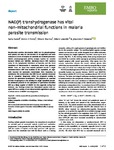NAD (P) transhydrogenase has vital non‐mitochondrial functions in malaria parasite transmission
| dc.contributor.author | Saeed, S | |
| dc.contributor.author | Tremp, AZ | |
| dc.contributor.author | Sharma, Vikram | |
| dc.contributor.author | Lasonder, Edwin | |
| dc.contributor.author | Dessens, JT | |
| dc.date.accessioned | 2020-03-10T08:28:59Z | |
| dc.date.issued | 2020-03-04 | |
| dc.identifier.issn | 1469-221X | |
| dc.identifier.issn | 1469-3178 | |
| dc.identifier.other | ARTN e47832 | |
| dc.identifier.uri | http://hdl.handle.net/10026.1/15442 | |
| dc.description.abstract |
Nicotinamide adenine dinucleotide (NAD) and its phosphorylated form (NADP) are vital for cell function in all organisms and form cofactors to a host of enzymes in catabolic and anabolic processes. NAD(P) transhydrogenases (NTHs) catalyse hydride ion transfer between NAD(H) and NADP(H). Membrane-bound NTH isoforms reside in the cytoplasmic membrane of bacteria, and the inner membrane of mitochondria in metazoans, where they generate NADPH. Here, we show that malaria parasites encode a single membrane-bound NTH that localises to the crystalloid, an organelle required for sporozoite transmission from mosquitos to vertebrates. We demonstrate that NTH has an essential structural role in crystalloid biogenesis, whilst its enzymatic activity is required for sporozoite development. This pinpoints an essential function in sporogony to the activity of a single crystalloid protein. Its additional presence in the apicoplast of sporozoites identifies NTH as a likely supplier of NADPH for this organelle during liver infection. Our findings reveal that Plasmodium species have co-opted NTH to a variety of non-mitochondrial organelles to provide a critical source of NADPH reducing power. | |
| dc.format.extent | e47832- | |
| dc.format.medium | Print-Electronic | |
| dc.language | en | |
| dc.language.iso | en | |
| dc.publisher | EMBO | |
| dc.subject | malaria | |
| dc.subject | oocyst | |
| dc.subject | ookinete | |
| dc.subject | sporozoite | |
| dc.subject | transhydrogenase | |
| dc.subject | transmission | |
| dc.title | NAD (P) transhydrogenase has vital non‐mitochondrial functions in malaria parasite transmission | |
| dc.type | journal-article | |
| dc.type | Journal Article | |
| dc.type | Research Support, Non-U.S. Gov't | |
| plymouth.author-url | https://www.webofscience.com/api/gateway?GWVersion=2&SrcApp=PARTNER_APP&SrcAuth=LinksAMR&KeyUT=WOS:000508086400001&DestLinkType=FullRecord&DestApp=ALL_WOS&UsrCustomerID=11bb513d99f797142bcfeffcc58ea008 | |
| plymouth.issue | 3 | |
| plymouth.volume | 21 | |
| plymouth.publication-status | Published | |
| plymouth.journal | EMBO reports | |
| dc.identifier.doi | 10.15252/embr.201947832 | |
| plymouth.organisational-group | /Plymouth | |
| plymouth.organisational-group | /Plymouth/Faculty of Health | |
| plymouth.organisational-group | /Plymouth/Faculty of Health/School of Biomedical Sciences | |
| plymouth.organisational-group | /Plymouth/REF 2021 Researchers by UoA | |
| plymouth.organisational-group | /Plymouth/REF 2021 Researchers by UoA/UoA01 Clinical Medicine | |
| plymouth.organisational-group | /Plymouth/REF 2021 Researchers by UoA/UoA01 Clinical Medicine/UoA01 Clinical Medicine | |
| plymouth.organisational-group | /Plymouth/Research Groups | |
| plymouth.organisational-group | /Plymouth/Research Groups/Institute of Translational and Stratified Medicine (ITSMED) | |
| plymouth.organisational-group | /Plymouth/Research Groups/Institute of Translational and Stratified Medicine (ITSMED)/CBR | |
| plymouth.organisational-group | /Plymouth/Users by role | |
| plymouth.organisational-group | /Plymouth/Users by role/Academics | |
| dc.publisher.place | England | |
| dcterms.dateAccepted | 2019-12-17 | |
| dc.rights.embargodate | 2020-3-11 | |
| dc.identifier.eissn | 1469-3178 | |
| dc.rights.embargoperiod | Not known | |
| rioxxterms.versionofrecord | 10.15252/embr.201947832 | |
| rioxxterms.licenseref.uri | http://www.rioxx.net/licenses/all-rights-reserved | |
| rioxxterms.licenseref.startdate | 2020-03-04 | |
| rioxxterms.type | Journal Article/Review | |
| plymouth.funder | LAP function in apicomplexan parasite development::BBSRC |


